
Gaffney is a city in and the seat of Cherokee County, South Carolina, United States, in the Upstate region of South Carolina. Gaffney is known as the "Peach Capital of South Carolina". The population was 12,539 at the 2010 census, with an estimated population of 12,609 in 2019. It is the principal city of the Gaffney, South Carolina, Micropolitan Statistical Area, which includes all of Cherokee County and which is further included in the greater Greenville-Spartanburg-Anderson, South Carolina Combined Statistical Area.
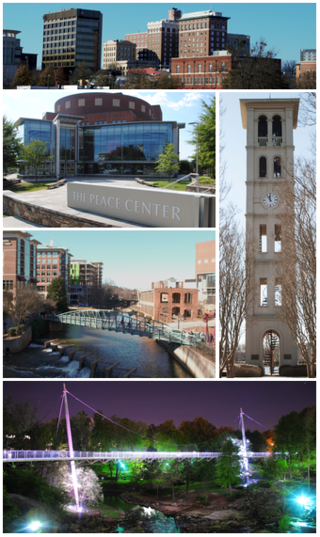
Greenville is a city in and the county seat of Greenville County, South Carolina, United States. With a population of 70,720 at the 2020 census, it is the 6th-most populous city in the state. Greenville is located approximately halfway between Atlanta, Georgia, and Charlotte, North Carolina, along Interstate 85. Its metropolitan area also includes Interstates 185 and 385. Greenville is the anchor city of the Upstate, a combined statistical area with a population of 1,487,610 at the 2020 census. Greenville was the fourth fastest-growing city in the United States between 2015 and 2016, according to the U.S. Census Bureau.
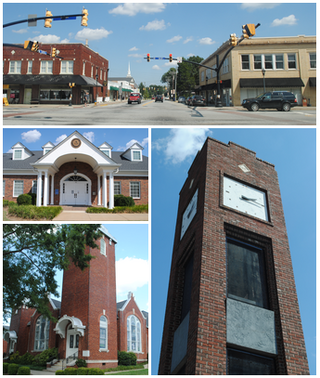
Simpsonville is a city in Greenville County, South Carolina, United States. It is part of the Greenville, SC Metropolitan Statistical Area. The population was 22,234 at the 2020 census, up from 18,238 in the 2010 census. Simpsonville is part of the "Golden Strip", along with Mauldin and Fountain Inn, an area which is noted for having low unemployment due to a diversity of industries including H.B. Fuller, KEMET, Sealed Air and Milliken. It is the 23rd-most populous city in South Carolina.

Greer is a city in Greenville and Spartanburg counties in the U.S. state of South Carolina. The population was 35,308 as of the 2020 census, making it the 14th-most populous city in South Carolina. Greer is included in the Greenville-Anderson-Greer, SC Metropolitan Statistical Area, which is part of the Greenville-Spartanburg-Anderson, SC Combined Statistical Area in Upstate South Carolina.
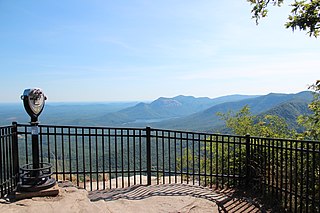
Caesars Head State Park is a park in northern Greenville County, South Carolina, that borders Transylvania County, North Carolina, and is reached via US 276. The eponymous rock formation, one of the highest points in Greenville County, is a granitic gneiss outcrop at 3,208 ft (978 m) above sea level on the Blue Ridge Escarpment of the Blue Ridge Mountains and rests roughly 2,000 ft (600 m) above the Piedmont below. The origin of the name "Caesars Head" is disputed, though the outcrop was most probably named for an early mountaineer's dog. Caesars Head State Park and Jones Gap State Park are jointly administered by the state Department of Parks, Recreation, and Tourism as part of the Mountain Bridge Wilderness.

Piedmont Number One is a former textile plant and former National Historic Landmark in Piedmont, Greenville County, South Carolina. It burned in 1983.
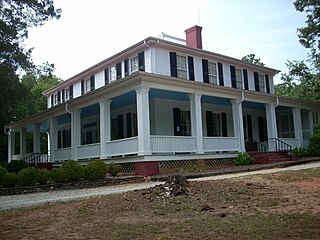
Ashtabula is a plantation house at 2725 Old Greenville Highway near Pendleton in Anderson County, South Carolina, USA. It has been also known as the Gibbes-Broyles-Latta-Pelzer House or some combination of one or more of these names. It was named in the National Register of Historic Places as a historic district on March 23, 1972. It is considered a significant example of a Lowcountry style plantation house built for a Charleston family in the Upstate in the early 19th century. It also is part of the Pendleton Historic District.

Chick Springs is a mineral springs in present-day Taylors, Greenville County, South Carolina, which from the mid-nineteenth to the early twentieth century served as the focus of a small Upstate South Carolina resort community.

Mills Mill was a textile mill in Greenville, South Carolina (1897-1978) that in the 21st century was converted into loft-style condominia. The building is listed on the National Register of Historic Places.

Monaghan Mill, now the Lofts of Greenville, is a former textile mill (1900–2001) in Greenville, South Carolina, that in the early 21st century was converted into loft apartments. The building is listed on the National Register of Historic Places.

Isaqueena, also known as the Gassaway Mansion, is a historic house in Greenville, South Carolina, and the largest private residence in the Upstate. In 1982 it was listed in the National Register of Historic Places.
Oaklyn Plantation is a historic plantation and national historic district located near Darlington, Darlington County, South Carolina. The district encompasses 40 contributing buildings, 6 contributing sites, 2 contributing structures, and contributing object. Founded as a forced-labor farm worked by black people enslaved by the land's white owners, it was one of the major plantation establishments of the county and served as the seat of the Williamson family for more than 200 years.
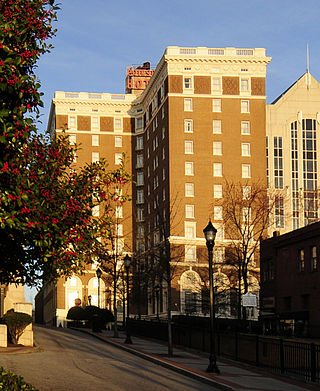
The Poinsett Hotel, or Westin Poinsett Hotel, is a twelve-story, landmark hotel in downtown Greenville, South Carolina, one of the first skyscrapers in Greenville. Named for Joel R. Poinsett, Secretary of War under President Millard Fillmore, the Poinsett replaced an earlier resort hotel, the Mansion House, built in 1824. In 1982, the Poinsett was listed on the National Register of Historic Places. The hotel is a member of Historic Hotels of America, an organization sponsored by the National Trust for Historic Preservation intended to promote heritage tourism.

Woodside Cotton Mill Village Historic District is a national historic district located in Greenville County, South Carolina. The district encompasses 278 contributing buildings and 2 contributing sites in an early 20th century urban South Carolina textile mill village. Centered on a mill founded by John T. Woodside in 1902, the district is located just west of the city limits of Greenville and is largely intact despite modernizations made by a succession of mill and home owners. The mill itself is a rectangular, brick, four-story building designed by J.E. Sirrine and built between 1902 and 1912. Eventually the mill became the largest cotton mill under one roof in the United States and one of the largest in the world.
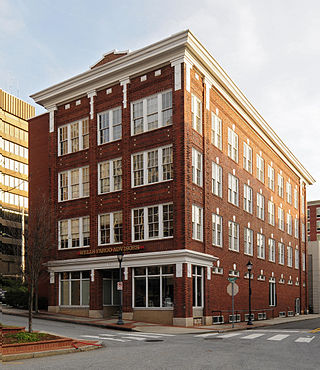
Carolina Supply Company is a historic commercial building located at Greenville, South Carolina. It was built in 1914, and is a four-story, brick building in a utilitarian Renaissance Revival style. The building housed a textile and industrial supply company that supplied mills with equipment and supplies. The building now houses Wells Fargo Bank.

Brandon Mill, now the West Village Lofts, is a historic textile mill complex, situated just west of the city of Greenville, Greenville County, South Carolina. The mill was built during the early decades of the 20th century and is one example of the mills in the Greenville "Textile Crescent" that became central to the economic development of the South Carolina upstate during this period. The complex was listed on the National Register of Historic Places in 2014, and the main mill has been converted into loft apartments.

The Wilkins House is a historic house in Greenville, South Carolina, built in 1878 by Jacob W. Cagle (1832–1910) for merchant and capitalist William T. Wilkins (1825–1895). It was listed on the National Register of Historic Places on July 19, 2016.

Vardry Echols McBee was an American saddlemaker, merchant, farmer, entrepreneur and philanthropist who has frequently been called, "the father of Greenville, South Carolina".

Cherrydale is a historic house in Greenville County, South Carolina, which serves as headquarters for the Furman University alumni association and as a venue for small dinners and receptions. It is a 4,960 square-foot, two-story building, with eleven rooms, eight fireplaces, and five bathrooms.
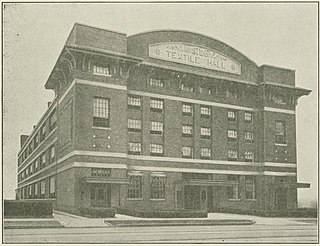
Old Textile Hall was a former building in Greenville, South Carolina, which from 1917 to 1962, hosted the Southern Textile Exposition, a trade fair for textile machinery. The building also functioned as a municipal auditorium for Greenville until 1958. Old Textile Hall was listed on the National Register of Historic Places in 1980, but it was removed after the building was demolished in 1992.































